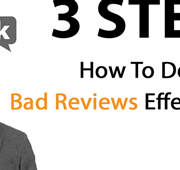How Can Audience Profiling Help Reduce Marketing Costs And Improve Online ROI?
Who is your online audience?
In most cases cusotmers say well, this is online right, so anybody can come & see my website.
Well, in this video we are going to see why audience is so crucial for defining online ROI for your business?
There are 3 ways How You Can Define Your Online Audience?
Let’s get started
1) Know Thy Business:
Treat your audience as if you are sitting right in front of customer across the table.
So if you customer is sitting across, before he makes buying decision.
Those questions need to be answered to yourself & then you’re content to be positioned in that manner. Because you would want to talk to your potential customers right?
You won’t want to talk to everyone at the street about your product. You would want to talk to customers who are going to give you time who are interested in buying from you.
Know your business, what are the questions, what are the problems. Do not optimize you online content for search engines, optimize for your customers problems & solutions that you provide to them.
Because, make no mistake your customers are looking at solutions on the web not searching for random website.
2) Purpose Of Your Audience:
Now this will vary from business to business. But you need to clearly understand, identify & established what the purpose of that audience is when he comes to your website or online presence.
- Is he coming for information?
- Is he coming to take some action? Or
- Is he coming to make some transaction? May buying from your store.
That purpose will be very clearly identified, established & presented to your customer.
Because many cases I have seen retail websites, giving away too much information without the main transactional calls. On the other hand I see lot of B2B websites giving a lot of transactional CTAs without providing right information. This is going to take your customer away. As I said customers are going to come to your website for solutions to their problems.
Therefore you need to be able to position yourself, your content, messaging in such a way you & they are very clear when they come online as to what they want & what has been delivered to them.
3) Audience Demography:
This is also an important aspect, but highly overlooked. Because you may have the relevant, engaging content, but if you are not hitting the right demography they you may be losing big opportunities.
Example: Is your business geared towards interacting with CEOs or you are trying to educate mid management through your online presence or you are trying to provide information to base level executives? Is that clear? Is it clear on your website? Do you know who is going to watch that content? Have your positioned your content? If you have very basic information given out & CEOs coming out watching out your content are they going to be impressed at all? No. Or you really give out high end stuff & your audience is the base level executives looking to find information so that he can create reports to present it to his boss, even he is going to get stuck. Because the way they will interpret, deceive for the language is going to be extremely different right?
So you really need to know who is going to read that content & how they are going to interpret it towards taking business actions & business decisions. So understanding of that demography becomes so crucial.
So those were 3 ways of establishing your online audience, there are so many other factors well but I have tried to cover top 3 according to me.
Share your feedback & queries in comments or email us @ business@zoomyourtraffic.com
Share, and Subscribe!!!
YouTube: https://bit.ly/2Br0GHk
Twitter: https://bit.ly/2rBRFqs
Facebook: https://bit.ly/2Lj7gnZ
Powered by:
ZoomYourTraffic Web Solutions
http://www.zoomyourbusiness.online
http://www.zoomyourtraffic.com









